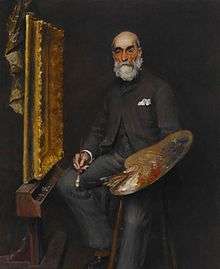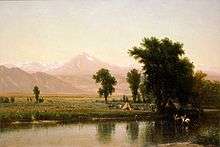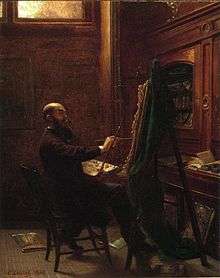Worthington Whittredge

Thomas Worthington Whittredge[1] (May 22, 1820 – February 25, 1910) was an American artist of the Hudson River School. Whittredge was a highly regarded artist of his time, and was friends with several leading Hudson River School artists including Albert Bierstadt and Sanford Robinson Gifford. He traveled widely and excelled at landscape painting, many examples of which are now in major museums. He served as president of the National Academy of Design from 1874 to 1875 and was a member of the selection committees for the 1876 Philadelphia Centennial Exposition and the 1878 Paris Exposition, both important venues for artists of the day.
Biography
Whittredge was born in a log cabin near Springfield, Ohio in 1820. He painted landscapes and portraits as a young man in Cincinnati before traveling to Europe in 1849 to further his artistic training. Arriving in Germany he settled at the Düsseldorf Academy, a major art school of the period, and studied with Emanuel Leutze. At Düsseldorf, Whittredge befriended Bierstadt and posed for Leutze as both George Washington and a steersman in Leutze’s famous painting, Washington Crossing the Delaware, now in the collection of the Metropolitan Museum of Art in New York City. He is associated with the Düsseldorf school of painting.
Whittredge spent nearly ten years in Europe, meeting and travelling with other important artists including Sanford Gifford. He returned to the United States in 1859 and settled in New York City where he launched his career as a landscape artist painting in the Hudson River School style.

Whittredge journeyed across the Great Plains to the Rocky Mountains in 1865 with Sanford Gifford and John Frederick Kensett. The trip resulted in some of Whittredge’s most important works—unusually oblong, sparse landscapes that captured the stark beauty and linear horizon of the Plains. Whittredge later wrote in his autobiography, “I had never seen the plains or anything like them. They impressed me deeply. I cared more for them than for the mountains... Whoever crossed the plains at that period, notwithstanding its herds of buffalo and flocks of antelope, its wild horses, deer and fleet rabbits, could hardly fail to be impressed with its vastness and silence and the appearance everywhere of an innocent, primitive existence." His 1876 painting On the Cache La Poudre River, Colorado depicts the river and plains in the foreground, with the Rockies in the background of the painting.[2]

Whittredge moved to Summit, New Jersey, in 1880 where he continued to paint for the rest of his life.[3] He died in 1910 at the age of 89 and is buried in the Springfield, New Jersey cemetery. Whittredge's paintings are now in the collections of numerous museums, including the Metropolitan Museum of Art in New York City, the Utah Museum of Fine Arts in Salt Lake City, and the Smithsonian American Art Museum in Washington, D.C.
Notes
| Wikimedia Commons has media related to Worthington Whittredge. |
- ↑ Thomas Worthington Whittredge Online at www.artcyclopedia.com
- ↑ Exhibit at the Amon Carter Museum in Fort Worth, Texas
- ↑ Wilson, Martha G. "New Jersey Guide; STATE OPERA OPENER", The New York Times, January 24, 1982. Accessed February 18, 2011. "Whittredge, who was born in Ohio in 1820, was a self-taught painter who came under the influence of the Hudson River School. In 1849, he traveled to Europe, where he studied and painted for 10 years. He moved to Summit in 1880, and lived there until his death in 1910."
See also
External links
- Works by or about Worthington Whittredge at Internet Archive
- Gallery of Paintings by Worthington Whittredge
- www.ThomasWorthingtonWhittredge.org 99 works by Worthington Whittredge
- Reynolda House Museum of American Art
- American Paradise: The World of the Hudson River School, an exhibition catalog from The Metropolitan Museum of Art (fully available online as PDF), which contains material on Whittredge (see index)
- Hudson River school visions: the landscapes of Sanford R. Gifford, an exhibition catalog from The Metropolitan Museum of Art (fully available online as PDF), which contains material on Whittredge (see index)